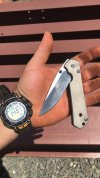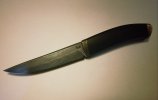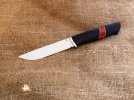- Joined
- Jan 23, 2007
- Messages
- 8,216
BOB LUM DELUXE TANTO
Blade is 6 3/8" of ATS-34, 3/16" bladestock, 11 5/8" overall.
I am so jazzed I saw this one first, which I think many can understand, that there was no need to say anything but "I want it". The top image is from yours truly, but the last two images display the color of the stag much more accurately:



Blade is 6 3/8" of ATS-34, 3/16" bladestock, 11 5/8" overall.
I am so jazzed I saw this one first, which I think many can understand, that there was no need to say anything but "I want it". The top image is from yours truly, but the last two images display the color of the stag much more accurately:



Last edited:







